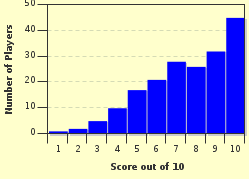Quiz Answer Key and Fun Facts
1. The original dates back to 1927 but the cover version by the biggest name in rock music prior to The Beatles made a mammoth Number One hit of it in 1960. The following lines were identical in both renditions. In the original, the singer repeats them but in the cover, the singer breaks into a heart-wrenching spoken monologue. What song are we talking about?
"Do the chairs in your parlor seem empty and bare?
Do you gaze at your doorstep and picture me there?
Is your heart filled with pain, shall I come back again?"
2. 1941 was when this hit first made a charting appearance at Number Six. The cover reached Number Eight in 1973 with both versions of the song being recorded by female voices. Here's a fair sample of the lyric with some broad clues that might steer you right... but be wary!
"A-toot, a-toot, a-toot-diddelyada-toot
He blows it eight-to-the-bar, in boogie rhythm
He can't blow a note unless the bass and guitar is playin' with him
He makes the company jump when he plays reveille"
What hit was it?
3. A huge Number One hit in the late 1950s, this song first charted at Number Six in 1931 for Ted Black and His Orchestra. It consisted of three verses and a chorus, each verse composed of three lines. I'm providing you with the first two lines of each verse. Do you know this one?
"On a day like today
We passed the time away
How you laughed when I cried
Each time I saw the tide
Now my broken heart aches
With every wave that breaks"
4. "______ and _______, I begged to be adored
Lost control, and tumbled overboard, gladly
That magic night we kissed there in the moon mist
Oh, but your lips were thrilling, much too thrilling
Never before were mine so strangely willing"
The blanks represent the two missing words of the title for a dreamy Number One hit in 1938. Two different rock and roll versions released in 1961, one by the Cleftones, another by Jan and Dean, didn't fare quite as well charting at Number 18 and 25 respectively. What song was it?
5. A Number One hit in 1939 was covered in 1957 and reached Number 20 on the Hot 100. Four years later, another version returned the song to the top of the charts once more. Finally, a third release entered the Hot 100 in 1976 and peaked at Number 14. What persistent song was it? Choices for a lyrical clue were limited but we'll give you the best that we've got.
"In the still of the night once again I hold you tight
Though you're gone, your love lives on when moonlight beams
And as long as my heart will beat, lover we'll always meet"
6. A song created in 1935 as part of a theatrical production is estimated to be the most recorded song of all time with over 25,000 versions. Oddly enough, very few of them made impressions on the Hot 100 or on the older charts of the 1930s and 1940s. Here's your lyrical hint:
"Your daddy's rich and your mama's good lookin'
So hush little baby don't you cry"
There's no point in pretending that you wouldn't know that the song's title is "Summertime". However, my question is - "From what musical opus does the song appear"?
7. This song, originally recorded by Guy Lombardo in 1931 and peaking at Number 12, topped the charts for an astonishing 13 weeks when Ted Weems released his instrumental rendition in 1947. The Marcels' cover of 1961 peaked at Number Seven. The whole lyric really only consisted of six lines and unfortunately, I can only provide you with two of them as a hint and here they are:
"Your kiss was such a sacred thing to me
I can't believe it's just a burning memory"
I expect this to be a tough one so don't feel bad if you're wrong. What was this hit's title?
8. "You leave the Pennsylvania Station 'bout a quarter to four
Read a magazine and then you're in Baltimore
Dinner in the diner, nothing could be finer
Than to have your ham an' eggs in Carolina"
Two things happened on December 7, 1941 - the Japanese bombed Pearl Harbor and this song started a nine week chart run at Number One en route to becoming the first Gold Record in recording history. During the 1960s and 1970s, four different cover versions made perfunctory appearances on the Hot 100. What song was it?
9. The groups involved in the British Invasion didn't resort to music from the by-gone ages very frequently but Chad and Jeremy revived an old Paul Whiteman Number Two hit from 1933 and had their second biggest Hot 100 hit with it themselves. With help from the slice of lyric which follows, do you know it?
"Whisper to the wind and say that love has sinned
Leave my heart a-breaking and making a moan
Murmur to the night to hide the starry light
So none will find me sighing and crying all alone"
10. "Creole babies with flashin' eyes softly whisper with tender sighs
And then you stop
Oh won't you give your lady fair a little smile
And then you stop
You bet your life you'll linger there a little while"
These words date back to a song that was initially a hit in the early 1920s. It resurfaced as a Number Three hit in 1960. What song was it?
Source: Author
maddogrick16
This quiz was reviewed by FunTrivia editor
kyleisalive before going online.
Any errors found in FunTrivia content are routinely corrected through our feedback system.

